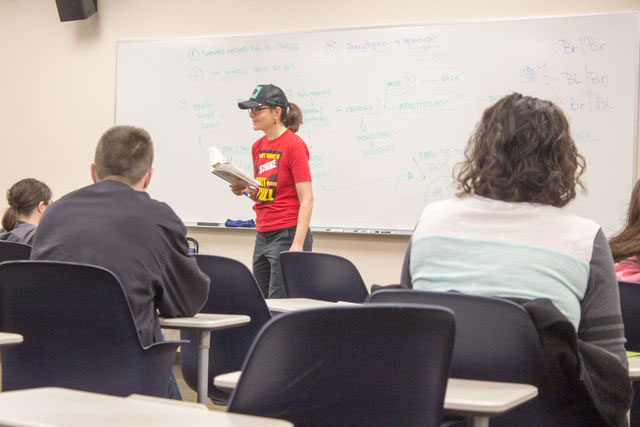There aren’t many cars on the road at 2 a.m. when Marilyn Sanders goes to work at In Motion Fitness. Around 8 a.m. she’ll be in class, and afterward she sets up in the library, poring over class readings and assignments.
Between her job and the course load of her six classes as a senior majoring in communication, there is little time for anything else — least of all campus politics.
“All I know about the strike is that Dr. Givertz talks about it all the time and that if they do go on strike, it’s only for two to five days,” Sanders said. “If I didn’t graduate I would be extremely mad, because I’m taking six classes, trying to graduate and I just want to get out of here … it would be a big dent in my life.”
Most students view the strike with detached curiosity, feeling they have little to no stake in the matter.
“I’m not super concerned. Because the strike is only supposed to last from Wednesday to Friday, and I actually have a nationals tournament for speech and debate that same week, so I wasn’t going to be here anyway,” said Adam Steele, a junior double majoring in communication and finance. “Graduation is all I’m concerned about. Time is money, if you want to go cliche.”
Other students like Mark Faaita, a post-baccalaureate student, are more actively involved in the politics of the strike. Faaita argues that having underpaid teachers affects students’ educational experience, and that the student body’s silence is a key part of the problem.
“The biggest problem with this is the students. The students don’t recognize why they need happier professors. They don’t recognize the opportunities that professors forfeit when they work at CSU campuses,” Faaita said. “CSU is one of the lowest paying university systems. There are professors at community colleges that are making more money.”
The only factor about the strike that seemed to catch the attention of the larger student body was the prospect that their semester would not count toward graduation, and for seniors, that they might not graduate this semester at all. However, in a recent email to Chico State students, President Paul Zingg addressed the rumors that the strike could jeopardize graduation for the class of 2016.
“The strike should not interfere with students being able to complete their courses and graduate on time,” the email states.
Zingg went on to assure students that all campus facilities and services would remain open during the strike, which begs the question — how? Will students attend empty classrooms? Will students show up to office hours to meet with educators who are not there? Furthermore, how can Zingg promise that graduation will not be affected?
Generally, the strike is a tactic designed to disrupt the system. If it does not disrupt the system, and only lasts two to five days as advertised, then what incentive does the administration have to meet the faculty’s demands? Up until now, the administration and the California Faculty Association have been at an impasse.
“CSU representatives have not been able to reach a salary agreement with the CFA through the collective bargaining process,” Zingg said in his email.
So what happens when the strike reaches its maximum time period of five days and the administration hasn’t budged?
“This is only phase one of a process,” Faaita said. “They don’t know what the next step will be. But if the demands aren’t met, that will lead to an escalation.”
Faaita led the way in assembling an informative meeting where students can learn more about the strike.
The people directly in charge of organizing the strike will attend the meeting and discuss CFA’s stance, Faaita said.
“I will be giving the administration’s position, including the cost and their other arguments,” he said. “The main thing is the cost. It’s a big number.”
According to the CSU strike Q&A document attached to Zingg’s email, the CFA’s proposal of a 5 percent raise, with a 1.2 percent raise for certain faculty, would cost the university system $102.3 million.
The Board of Trustees made a counter proposal of a 2 percent raise, which would equate to $33 million. The document argues that additional costs of the CFA’s proposal bring it to $143 million, and the money simply is not in the budget to cover that.
But Faaita sees the focus on the high numbers as a rhetorical move to mask the mismanagement of the CSU budget.
“There are more admin then there were five years ago, they continue to get raises, they make way more than the faculty. If money is the primary concern and something we should all be worried about, then the administration needs pay cuts across the board,” Faaita said.
The informative meeting for students will take place on March 8, at 6 p.m. in the BMU 210.
Eric Couderc McGuire can be reached at orionnewseditor@gmail.com or @ericcoudercmcg on twitter.






Megan // Mar 8, 2016 at 10:25 pm
“However, in a recent email to Chico State students, President Paul Zingg addressed the rumors that the strike ‘COULD’ jeopardize graduation for the class of 2016. ”
Need to fix this sentence to “Will Not” since the following quote makes that statement untrue.
Following quote: ‘“The strike should not interfere with students being able to complete their courses and graduate on time,” the email states.’